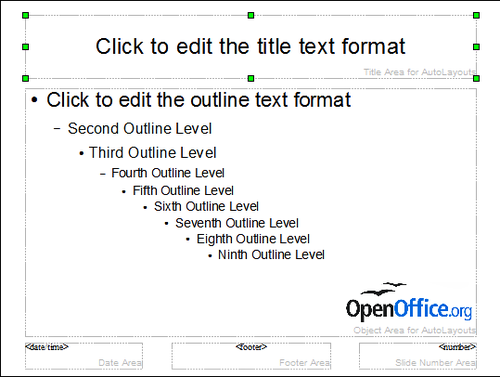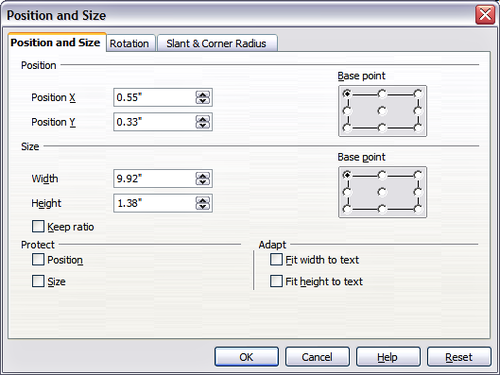Modifying the size and shape of default text areas
When a slide master is opened for editing, it contains five areas, as shown below:
- Title area for AutoLayouts
- Object area for AutoLayouts
- Date area
- Footer area
- Slide number area
Click with the left mouse button on any of these areas to display eight green squares (handles) around the rectangle. Use these handles to modify the size and position of the area.
- To change the position, move the mouse towards one of the edges, away from the green handles, until the cursor changes shape, then click the left mouse button and drag the area to the desired position. (The shape of the cursor to move and resize objects is operating system specific, therefore no image is provided.)
- To modify the shape and size of one of the rectangular area, use one of the 8 green handles. Use the handles in the corners to modify both the sides of the rectangle simultaneously; the handles in the middle of the sides modify only one dimension at a time. The shape of the mouse cursor usually changes when over the handle, giving a clear visual indication of how it will affect the shape of the rectangular area.
To more accurately control the shape and size as well as the position of the default text area, instead of using the mouse it is better to access the Position and Size dialog box. To do that, first select the rectangular area by clicking on any point inside it, then either press F4 or from the main menu select Format > Position and Size. The dialog box shown below is displayed.
The functions of this dialog box are explained in the Draw Guide, so only a short description of the most important fields is provided in this chapter.
Use the Position section to specify the X (horizontal) and Y (vertical) position of the rectangular area. The values represent the distance of the base point (selected on the right hand side) relative to the top left corner of the slide.
Use the Size section to specify the width and height of the rectangular are. Select as the base point the part of the rectangular area that remains fixed. The default setting (top left corner) means that the when resizing the area, the position of the top left corner of the area will not change.
You can also use the Rotation tab of the dialog box to rotate one of the axes by 90 degrees to obtain a modern looking layout. In general it is preferable to use only right angles for ease of editing, although the program does not impose restrictions on the values that can be used.
Further modifications to the default text areas
Besides the shape, size and position, it is also possible to modify other aspects of the 5 areas of the slide master, such as the background, add a border, alignment relative to the slide and position relative to other objects.
While background style and line style of an area can be accessed from the Format menu, in order to access the Alignment and Arrange menus you need to either open the Drawing toolbar or use the context menu. To display the Drawing toolbar, select it in View > Toolbars; to open the context menu, right-click on the edge of the rectangular area after selecting it. On the Drawing toolbar, click the arrow next to the Alignment or Arrange icon (highlighted below) to display choices. See the Draw Guide for details.
The date area, footer area, and slide number area do not automatically appear on every slide, even though you have defined them. In order to show them, you need to close the Master View and select the desired field from the menu: Insert > Page number or Insert > Date and time. This procedure is explained in detail in Chapter 8 (Adding and Formatting Slides, Notes, and Handouts).
| Content on this page is licensed under the Creative Common Attribution 3.0 license (CC-BY). |


